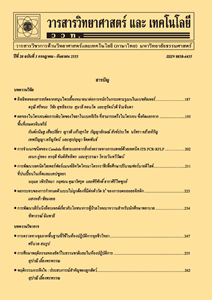การปรับปรุงค่าออกเทนของแก๊สโซลีนด้วยปฏิกิริยาต่อเนื่องสองขั้นตอน : ตอนที่ 1 การใช้โทลูอีน-เมทิลไซโคเฮกเซนเป็นสารตั้งต้น
Main Article Content
Abstract
บทคัดย่อ
การใช้พลังงานเชื้อเพลิงปิโตรเลียม โดยเฉพาะแก๊สโซลีนได้เพิ่มจำนวนมากขึ้นอย่างรวดเร็ว โดยเฉพาะอย่างยิ่งการใช้สำหรับการคมนาคม ผลของการใช้พลังงานเชื้อเพลิงอย่างไม่จำกัดและไม่มีประสิทธิภาพทำให้เกิดผลกระทบต่อมลภาวะทางอากาศ ไม่ว่าจะเป็นการเพิ่มปริมาณคาร์บอนไดออกไซด์ ปริมาณเขม่าดำ รวมทั้งไอระเหยของสารอะโรเมติกส์ เป็นต้น ดังนั้นการลดมลภาวะที่เกิดจากการใช้เชื้อเพลิงจึงเป็นสิ่งสำคัญ หน่วยงานดูแลสภาพแวดล้อมได้กำหนดข้อกำหนดเรื่องคุณภาพของแก๊สโซลีนให้ดีขึ้น โดยลดปริมาณอะโรเมติกส์ให้เหลือต่ำกว่าร้อยละ 35 เปอร์เซ็นต์ อะโรเมติกส์เป็นสารเคมีที่มีค่าออกเทนสูง ดังนั้นการลดปริมาณอะโรเมติกส์ในแก๊สโซลีน อาจส่งผลให้ค่าออกเทนต่ำลง วัตถุประสงค์ของบทความนี้เพื่อต้องการอธิบายถึงแนวทางในการปรับปรุงคุณภาพของแก๊สโซลีน โดยการลดปริมาณอะโรเมติกส์ (aromatics) และในขณะเดียวกันค่าออกเทนยังคงมีค่าสูงอยู่ ค่าออกเทนเป็นตัวเลขที่แสดงถึงความสามารถในการต้านทานการน๊อคของเครื่องยนต์เบนซิน น้ำมันที่มีค่าออกเทนสูงประสิทธิภาพในการต้านทานการน๊อคของเครื่องยนต์ดี ค่าออกเทนของสารแต่ละชนิดมีค่าแตกต่างกันซึ่งขึ้นกับโครงสร้างและขนาดโมเลกุล ถึงแม้ว่าอะโรเมติกส์มีค่าออกเทนสูง แต่ส่งผลร้ายต่อสุขภาพ ดังนั้นจึงมีความจำเป็นอย่างยิ่งที่ต้องลดปริมาณอะโรเมติกส์ให้ต่ำลง ในที่นี้ได้แสดงถึงการเปลี่ยนสารอะโรเมติกส์ให้กลายเป็นไอโซพาราฟิน (iso-paraffins) โดยอาศัยปฏิกิริยาต่อเนื่อง 2 ขั้นตอน ไอโซพาราฟินนอกจากมีค่าออกเทนสูงแล้ว ค่าปริมาตรจำเพาะ (specific volume) ยังมีค่าสูงกว่าอะโรเมติกส์ซึ่งเป็นการเพิ่มปริมาณของแก๊สโซลีนได้อีกทางหนึ่ง
คำสำคัญ : แก๊สโซลีน; อะโรเมติกส์; ค่าออกเทน
Abstract
Petroleum fuel demand, especially gasoline in the transportation sector, has continued to grow. Rapid increase in energy consumption and inefficient use of energy could cause air pollution such as increasing amount of carbon dioxide, particulate matters, soot and volatile aromatics. Therefore, a reduction of pollutants in combustion processes has become more concerned. The EPA has forced the strong regulations to control the gasoline quality. One of them is the reduction of aromatic content in gasoline and its value must be no higher than 35%. Aromatic compounds normally have high octane number. The lower aromatic content in gasoline, the lower octane number of gasoline is. This paper presents a strategy to reduce aromatics, but preserving the octane number. The octane number is a number that indicates the knocking resistance of the gasoline engine. The higher octane number, the higher the knocking resistance is. Octane number is different for each compound and it depends on the molecular size and molecular structure. Although aromatics have high octane number, they could cause adverse health effects. Therefore, aromatic contents must be reduced. Thus, this paper presents a strategy to reduce aromatic by changing its molecular structure to iso-paraffin via two consecutive reactions. It is evident that iso-paraffins have not only less adverse effects and harm but also higher octant number and higher specific volume.
Keywords: gasoline; aromatics; octane number


